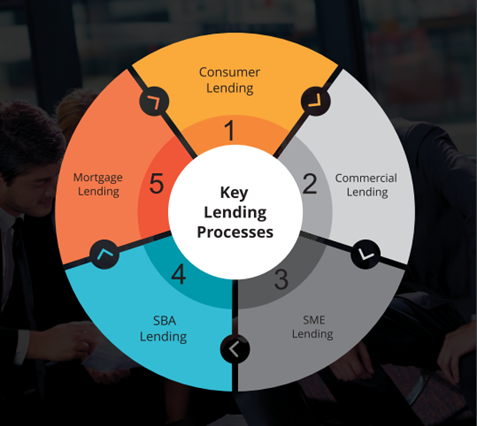Before I dive into the merits of a robust loan origination system, let’s talk about baking!
Let’s say you decide to bake a cake for a client and prepare the perfect batter with the right consistency. But when it comes to placing it in the oven, you know the old oven doesn’t get to the right temperature to bake the cake. You try other make-do methods to bake, but, in the end, the final cake was too dry, and you had an unhappy customer.
So, what went wrong? You did not have the right equipment in place!
Similarly, banks have the potential to deliver exceptional customer experience. But often, their legacy systems become a roadblock.
The global lending space is evolving at a dynamic pace, forcing banks and credit unions to re-evaluate how they can handle the challenges and the opportunities that come with it. Several trends in today’s post-pandemic market shape how financial institutions (FIs) can capitalize on new lending opportunities. But for that, banks need to invest in the right loan origination system to create a sweet spot in the competitive market.
The Challenges of Digital Lending and the Case for Loan Origination Systems
With everything becoming digital by the day, we wonder if traditional banking is dead. With fintech organizations taking the spotlight, banks and credit unions are finding it much harder to sustain their position in the market. According to research by McKinsey, 40% of consumers use a fintech platform for their day-to-day financial activities. On top of competitive pressure, another key challenge identified by Cornerstone Research includes revenue recession, which is a serious challenge for banks. With net interest margins (that are significant revenue drivers) on the decline, it has only dragged down banks and credit unions. For FIs to reclaim their positions in the industry, it is necessary to power their enterprise with a holistic loan origination system that can offset the current challenges.
End-to-end Management of Lending Process with a Loan Origination System
Offering loans should be simple, but traditional lending systems can often make it chaotic! With consumers preferring to go the digital way, a digital loan origination system is a must-have for lenders to survive in today’s world.
A loan origination system is designed to manage the entire lending process, from origination to disbursement. FIs can leverage a comprehensive loan origination system to facilitate customer onboarding once the borrower has requested a loan. A loan origination system helps with multiple aspects of the loan application process, including checking credit history, loan pricing, digital KYC, and disbursal.
Catering to All Types of Loans with a Loan Origination System

There are various reasons people borrow money, whether to fund a house or car, expand their business, or fund their higher education. FIs need to leverage the right solution to bring agility and flexibility to their lending processes and cater to all kinds of loans, whether SME, commercial, retail, or SBA loans.
Without a loan origination system in place, lenders depend on emails, spreadsheets, calls, and other manual processes. A simple error in baking means starting all over again, right? Similarly, as humans, we are all prone to making assumptions and overlooking flaws, all of which can be too expensive in terms of cost and productivity for banks. So how can loan origination help? A modern loan origination system can offer
- Reduction in processing turnaround time
- Higher accuracy of data entered
- Real-time report generation
- Greater customer satisfaction
- Increase in tracking and monitoring of loan
- Improved quality and compliance
Behind the Scenes of the Loan Origination Process
A typical loan lifecycle includes the entire process from application submission to disbursement. It involves five key stages, which are:
- Loan application: It includes obtaining applicant information and assisting them with the loan application
- Loan processing: It involves the collection and verification of the applicant’s information
- Underwriting: Loan underwriting is a process for the lender to determine if the loan is a good risk and decide whether to grant the request
- Disbursal: This is the final stage where final details are completed and checked, and the loan is disbursed
- Servicing: It involves all the servicing activities like sending reminders and ensuring the loan is repaid on time
The 7 Must-have Capabilities of an Ideal Loan Origination System
The process requirements tend to be unique for every institution. Banks today need an optimal solution that is adaptable and can support the ever-changing business and process dynamics. When selecting a loan origination system, look out for these key features before selecting one for your organization:
1. End-to-end automation of the lending process
You first need to consider whether the loan origination system can automate the end-to-end lending process, which can centrally orchestrate the workflow from lead management to disbursement and then to servicing.
2. Single unified interface
A loan origination system needs to be able to combine all the lending process’s functionalities under one umbrella. This will reduce manual error and operational lags as well as provide customers with a consistent and standardized experience from the organization.
Let’s take the example of going to a McDonald’s drive-through, and you order a burger and fries. You receive the burger right at the window. But for the fries, if they ask you to come inside, you’ll be baffled, right? That is precisely what a broken experience is that can lead to bottlenecks for the company and a bad customer experience! In a loan origination system, a unified process orchestration can bring consistency and efficiency to the lending process.
3. Digitize manual and paper-heavy process
A loan origination system should easily capture information in digital form, which can help with control, retrievability, traceability, and archival. A loan origination system can also drastically reduce cycle time and manual errors.
4. Seamless integration with core banking systems
The lender organization should be able to seamlessly integrate with their core banking and legacy systems without custom-coding. They should be able to automate several parts of the process, such as credit score validation, lead management, and blacklist checks.
5. Automation and configurability of credit policy
Credit and deviation policies usually start with guidelines and become standard through the repetitive occurrence of similar cases, only wasting knowledge workers’ time. A business rules management-based automation engine can automate repetitive process scenarios and empower the workforce to focus on higher-value transactions.
6. Handle compliance through proactive management
A loan origination system should allow your FI to proactively manage compliance and orchestrate processes for better traceability and audibility.
7. Accelerate deployments
The time to market is critical, and flexibility is needed to cope with fast-changing market needs. A loan origination system should provide flexibility to make the solution work in your context and environment rather than being imposed on the standard feature set offered by the vendor. A framework-based approach can help you cut short the implementation time and provide you with the benefit of faster time-to-market.
The Right Loan Origination System Can Make All the Difference
Consumers want their loan requests to be processed faster. Just like baking the perfect cake, it is about having the right equipment (technology) and the right hands (partnership) who can help deliver a long-term solution to keep your organization at the cutting edge of digital advancement. Contrary to the old idiom, you CAN have the cake and eat it too! Simply put, with Newgen, FIs can enjoy the right technology and partnership benefits. Newgen’s loan origination software can bridge operational siloes, unify your front and back office, and streamline your lending process.
FAQ
1. What is the difference between loan management software and loan origination software?
A loan origination software (LOS) is used to smoothly manage the customer onboarding process once the borrower requests a loan. In comparison, loan management software (LMS) is typically used for all functions post-loan disbursal. This includes ensuring loan repayment, sending notifications, and providing customer service.
2. What five key stages of a loan origination process need automation?
The five key stages of a loan origination process that needs to be automated to improve efficiency are loan application, processing, underwriting, disbursal, and servicing.
3. How can a loan origination system benefit my financial institution?
A loan origination system can allow your organization to seamlessly onboard customers, competitively underwrite loans, reduce overall expenditures, ensure regulatory compliance, and future-proof your business with efficiency, scalability, and agility.
You might be interested in



25 Sep, 2025
Transforming Enterprises with Newgen’s Business Process Management Software

